Your Lucrative Consulting Career Continues The Retail Store Has Hired You Once Again
Profitability Case - A Framework for the Most Common Case Type in Consulting Interviews
As you already know, there are several common case types that occur in case interviews you should familiarize yourself with. Profitability case interview questions are the most frequently used case types during case interviews for management consulting roles. Make sure to be prepared for them by internalizing our five steps to crack profitability cases.
Profitability Questions – The Number 1 Reason For Most Consulting Projects
The most common reason why firms instruct consulting firms with their projects is that they struggle with their profitability. You will have to find out the root cause of their declining profitability. Examples arefalling sales,rising costs, orboth. Your task will be two-fold: performing a structured and quantitative analysis of the data toisolate the problem and then finding a promising solution for the problem.
Solve the Profitability Case Using This Case Example
We will explain the procedure along with a profitability case example just like the one you might encounter in a consulting interview: Your client is a chewing gum manufacturer (you can find the entire case here). The CEO of the manufacturing company is concerned because his company is experiencingdeclining profitability. Please investigate the reasons for the decline and give suggestions for improvement.
The Five Steps to Crack a Profitability Case Problem
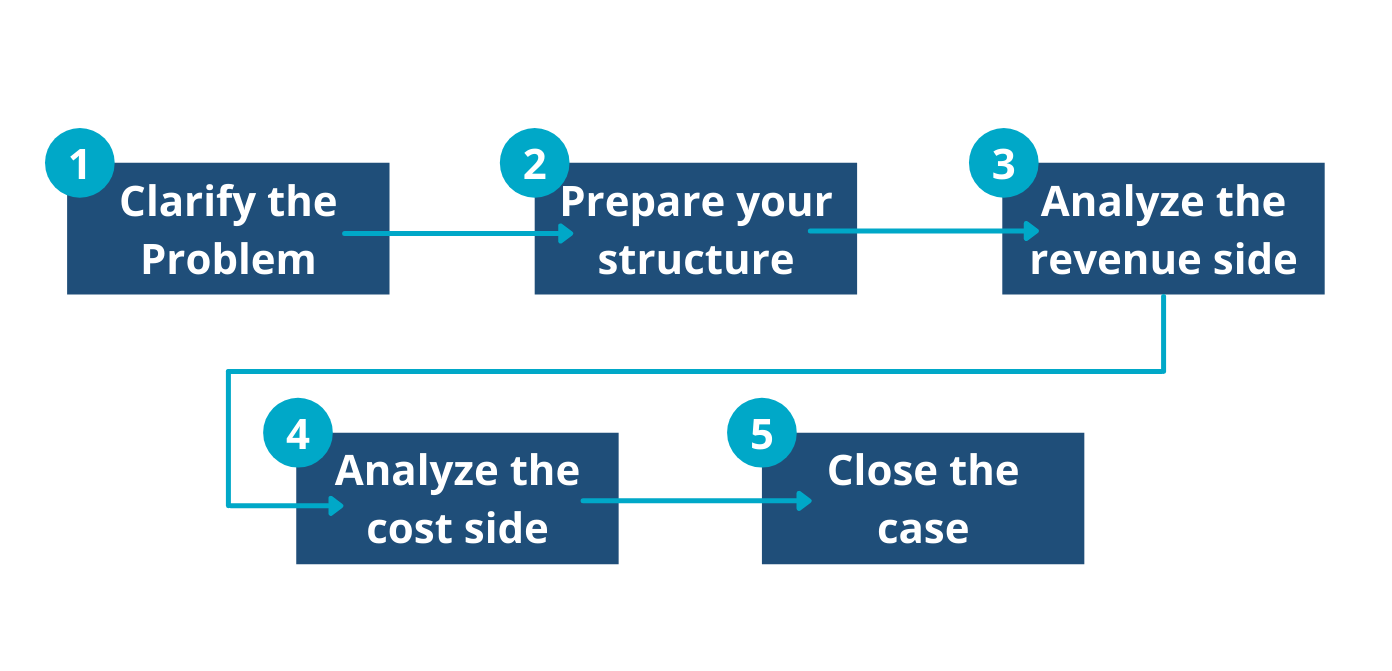
1. Clarify the problem
Remember the 4 commandments!
Take notes! Start with restating the problem: "Just so we are on the same page, our main objective is to determine the reasons behind the decline in profitability for a chewing gum manufacturer and provide recommendations to improve the profitability of the business, is that correct?"
2. Prepare your structure
"Thank you, may I take a minute to prepare my structure?"
As mentioned in the introduction, the terms "declining profitability, falling sales orrising costs" hint at a profitability case. You now have toisolate the problem andquantify it. A good start to analyze a profit problem is by using theprofitability equation:

When profits go down, you either have adecline in revenue,rising costs, or both. The best way to find the root cause is to sketch the problem as an issue tree. Start with the more promising part, for instance, revenues - because the market is highly competitive. Obviously, you would share that thought with your interviewer and be on the lookout for hints. E.g. 'I am going to look at revenues first since in a competitive market like the market for chewing gums I'd expect this to be a big driver.'
You can further break down the profit tree like below:
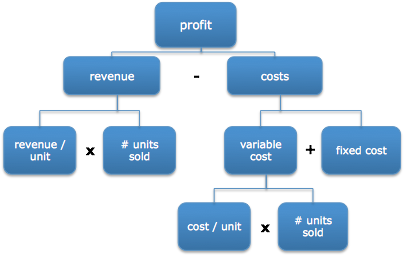
Now you can start with one of the branches. Let's take the revenue side.
Try to start with the branch of the tree that also has the biggest impact on the case solution (see pareto principle for more details). Shareyour hypothesis with the interviewer and watch out for hints if you are on the right track.
3. Analyze the revenue side
Whenever you get the information that something has changed:quantify it!Ask byhow muchand in what time period. And very importantly: SEGMENT the revenue streams! You can ask the interviewer whether you can segment the revenues into its component parts. If the interviewer prompts you to do the segmentation, you can think about different customer segments (small business / large business, etc., age group, sex, etc…), product lines, or regions (South America, Asia, etc). This segmentation will help you isolate the root of the problem. You'll be able to develop better and more targeted analyses.
A proper tool to come up with segmentation is the ABC analysis.
For example, when helping a chewing gum manufacturer improve his profitability, you may ask: "What are the revenue sources?". The interviewer tells you that all revenue comes from two products: Flavored and non-flavored chewing gums. At this point, you might want to know the development of sales over the past couple of years. "How have sales figures developed over the years for both products?" He shares the following diagram with you:
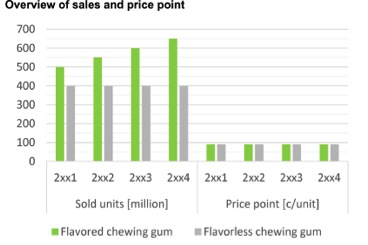
It now becomes clear that revenue is not the problem because it has grown steadily in recent years. Therefore, it must be costs that rose significantly, leading to a drop in profitability.
If you've found the biggest driver of the problem, you oftentimes have to switch to a more qualitative framework like the 4 Cs to find the underlying root cause! For example: when you have less revenue, but the price is the same and units sold dropped you have to find out why. Is there anew competitoron the market? Do you havequality problems, or did you just stop a marketing initiative that you ran for years prior to this drop?
4. Analyze the cost side
Now explore the cost side. You know that costs can be broken down into direct and indirect costs. You can then inquire about the breakdown of costs: "Please tell me about the direct/indirect cost split for the products." The interviewer hands you the following graph:
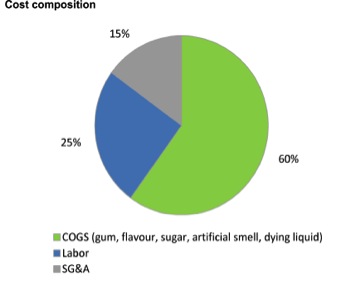
As we know that there are two different product lines, it is advisable to calculate theirmargins to check if there is a more profitable product line. You calculate the margin for both products based on the following formula:

"I'd like to calculate the margins for both products; do you have information on the different prices and costs for each of them?" The interviewer hands you the following graph:
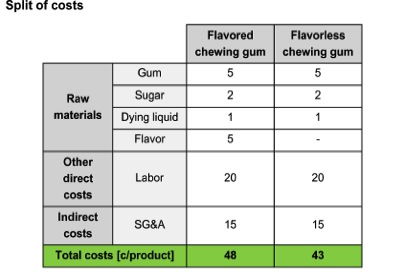
Based on this, you calculate the margins:
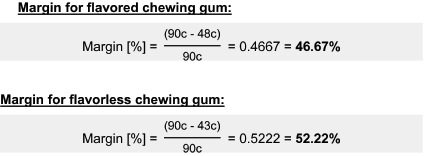
5. Close the profitability case
"Analyses show that the product whose sales have increased (flavored chewing gum) is also the one with lower margins due to the added flavor. Therefore, total profit margins have decreased while sales have increased."
After you have determined the root cause, you must develop a good logical solution (e.g., developing a competitive response, starting a marketing initiative, etc.)
It is important to stay structured even if you think you have reached the final stage. Therefore, categorize your approaches for instance by short-term/easy to implement solutions and long-term ones.
Short term
- Negotiate with current suppliers.
- Look for other suppliers (form partnerships or buy greater amounts with batch discounts).
Long term
- Vertical integration.
- Release new products with better margins (e.g., low-calorie flavor gum or tooth cleaning gum).
- The client could also increase the price of the flavored gum, risking decreasing sales if customers do not see any added value with the price rise (high price sensitivity).
1. MBB Final Round Case – Non-Profit Museum Revenue Increase
Style: Interviewer-led (McKinsey style)
Topics: Pricing, Profitability analysis
Your client is'Muse 19', a Museum in Paris with a large collection of 19th-century artifacts, predominantly paintings, and sculptures. The museum is run by a non-profit organization based in France. The museum is quite popular amongst students, artists, and tourists. Last year the museum attracted almost 2 million visitors. Despite this, the museum'srevenue has been declining for the last three years. Surprisingly, other museums of similar nature have been doing much better than Muse 19. The museum director has approached you for advice. Read the whole profitability case.
2. Caribbean Island – MBB Final Round
Style: Candidate-led (usual style)
Topics: Brain teaser, Market sizing, Profitability analysis, Valuation
A wealthy client has recentlybought an island in the Caribbean. She has engaged us to identify possible uses for her new island. Read the whole case.
3. Incos Pens
Style: Interviewer-led (McKinsey style)
Topics: Market entry, Market sizing, Profitability analysis
Incos is a global manufacturer of writing products with divisions in North America, Europe, and South-East Asia. Their global sales are$60 m and their profits amounted to around$30 m. Their European division who manufactures and sellsdisposable pens is experiencing flattening sales and a decreasing profit. The client hired you to help him come up withsuggestionsto get profits back on track. Read the whole case.
4. Espresso, Whatelse?
Style: Interviewer-led (McKinsey style)
Topics: Market analysis, Operations strategy, Pricing, Profitability analysis
Espresso Whatelse is an Italian company that produces coffee and espresso machines since 1908. It is the Italian market leader and has a strong presence overall in Europe. In 2019,Espresso Whatelse has increased its revenuesbut it has seendeclining profit margin. Your client wants to understand the root causes of this 2019 trend and how to increase its profit margin again. Read the whole case.
5. DHL Consulting case: Books & Codes
Style: Candidate-led (usual style)
Topics: Operations strategy, Profitability analysis
A friend of yours recently got promoted to the position ofdirector of a university library. Yesterday, your friend received a call from the Ministry of Education, who offered him to be part of a nationalRFID pilot with his library. As your friend is unsure if he should pursue this option, he asks you for your advice. Your task is toassess the RFID technology for his library. How would youapproach such a request? Read the whole case.
Profitability Frameworks - Key takeaways:
Profitability problems are frequent in consulting case interviews. To solve a profitability problem:
- find the root cause using theprofit formula
- use atree structure
- go down one branch at a time andsegment it
- quantify and look for trends
- locate the biggest driver
- find out why throughqualitative analysis and additional analysis (e.g., using the 4 Cs Framework).
Source: https://www.preplounge.com/en/case-interview-basics/case-cracking-toolbox/identify-your-case-type/profitability-case
0 Response to "Your Lucrative Consulting Career Continues The Retail Store Has Hired You Once Again"
Post a Comment